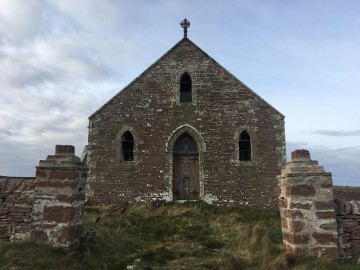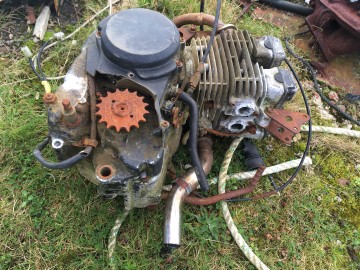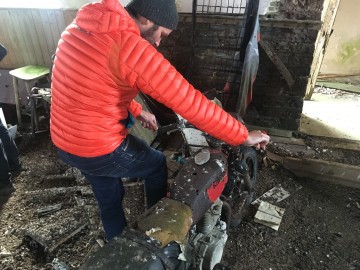Orkney
Community gravity battery
Our task was to build a gravity battery on the small island of Eday in Orkney, Scotland. We arrived on a Sunday evening in late October with nothing, no tools or materials of any kind, and by Thursday we were running a public demonstration of a gravity powered Casio keyboard playing ‘Ode to Joy’. Here is a technical account of the process, which was not unlike a 72-hour Scrapheap Challenge, but involving the whole community.
Three of us left the island of Madeira early on the Friday, bidding farewell to sunshine and flower blossoms. The fourth in our party, Mohammed, coming from rural Sweden, met us that night in Inverness. By Saturday morning we had reached Kirkwall, on the Orkney Mainland. Laura arrived on the next flight, and over a lunch of fish and chips we shared our thoughts about the gravity battery, including what sort of scrap we might use to make it—an old motorcycle, a car or tractor, even a crashed Vespa someone had mentioned. There was also the question of what we should do with the energy it released. Previously we had powered a record player; this time we had in mind a lamp, or an old radio playing the BBC shipping forecast. None of us had ever been to Eday, an island of ten square miles with a population of just 130 people.
We woke Monday morning to the sound of a large wind turbine spinning fast outside the hostel, telling us the weather conditions. In fact the island grid is powered entirely by renewable energy—Eday’s experimental and community-driven use of renewables, including wind, tidal, and solar, as well as storage in hydrogen fuel cells, is the main reason we were keen to visit. Even the electric heaters in the hostel are powered at certain times by energy overflow from the wind turbine outside. Everyone we met on Eday was extremely well versed in energy generation and storage, including the seven children of the local primary school who spoke knowledgeably about electrolysers and curtailment.
We met Clive, our local fixer and project partner with Eday Renewable Energy Ltd., after a solid breakfast of porridge and bacon butties. Before we set out to gather scrap materials and tools, he gave us a pep talk of sorts: ‘This may look like chaos. But I assure you the machine will be built, it will be demonstrated, and you will leave happy on the ferry Friday morning.’ In the car he pointed out the island’s landmarks and mentioned some of the people we would likely meet that day. As far as we could tell you were not allowed to have the same name as anyone else on the island—when a second Kate arrived she was renamed Katie, and the second Mike became Mick. This we decided was as good a definition of a small island as any we’d heard. Clive warned us that the community would need some convincing before they got involved. We should expect questions like: What’s in it for Eday?
The first stop of the morning was the Old Church, which had been bought by a woman from London with big plans in the 1980s and has sat derelict ever since. Here we found an old motorcycle, a red Kawasaki, parked in the middle of the church amongst other scrap (a Super 8 camera, a record player, a typewriter). The bike had only 12,000 miles on the odometer, but it was buried under a thick blanket of corrosive pigeon shit, and all of its insides were seized beyond reasonable use. We took a lot of photographs. At the second stop, the New Church a minute down the road, we found a large brass bell salvaged from a sunken steamship. We thought we might use it as a weight for the gravity battery. Permission would have to be sought, Clive said. The third stop was an old mechanic’s back garden, full of rusted cars and a jumble of engine parts. ‘Did he die?’ someone asked. ‘No, just left the island’, Clive replied. James opened the hood of an old BMW and found a live rabbit inside.
We checked out the building site next, a shed by the pier used mostly for deliveries. It had a forklift and plenty of room—the first real success of the day. We would have to clear out twice a day when the ferry docked, but aside from that it was ours. We agreed it would do very nicely. Our other Eday contact, Andy, who works with Clive, met us at the shed. From there we drove to an old quarry on the far side of the island, a five-minute journey. As we walked around the site, staring up at the sheer sides from the quarry base, someone had an epiphany about making a gravity-powered keyboard. Andy, it turned out, not only knew how to play (he was currently the church organist), he had also been the keyboardist in an eighties band called Freeez, who had a number one single in the US dance charts (‘IOU’). We all agreed that if we could get hold of a scrap keyboard the issue of what to do with the energy released by the gravity battery was solved.
After lunch at the hostel we met some people from the community in a building next to the island shop. The key moment in this meeting was the suggestion that Mick, who was spotted leaving the shop outside, had an old motorcycle in his barn; someone ran out to talk to Mick and he kindly agreed to let us follow him home. He was a large man in a CCCP shirt, who told us in a Liverpool accent to mind the ducks and sheep. He opened the barn and dragged out an old dirt bike, its wheels clogged with hay; he used an axe to free up the front wheel, and four of us rolled it up the driveway in the rain and waited as someone found a van to bring it back to the pier shed. We were cold and wet, and the light was fading on our first day, but we had a motorcycle and a rough plan. We ate a hearty dinner at Roadside, the island’s former pub turned occasional restaurant (actually just a dining room in a private house), and then returned to the hostel to drink whisky and sleep.

We arrived at the shed Tuesday morning at 9:05 to find several islanders already waiting in boilersuits, ready to work. We introduced ourselves, made some tea, and set up to start cutting into the bike, while Clive got on the phone to order a new chain from the Mainland—the only part the bike was missing. We quickly sourced some necessary tools from generous community members, including an angle grinder, a lathe, and a socket set, and got to work. By lunch the bike was stripped, leaving only the parts necessary for the gravity battery—the frame, engine, and rear axle. In the afternoon two of us went to the school to give a workshop while the others stayed back at the shed. The wind blew and the rain poured down. Countless cups of tea were consumed. Soon the day was over, the children went home, the shed was locked up, and at the hostel Mohammed made his special dal. It was Halloween night on a remote Scottish island, so obviously we watched The Wicker Man. More whisky was consumed.

The challenge now was how to get the gravity battery over the fence and down into the quarry, our chosen site for Thursday’s demo. We noticed a large tractor—who did it belong to? Could somebody drive it there? Health and safety was still a headache that Andy was dealing with, negotiating with the property owners in England and the insurance company. It was blowing a gale all the previous night and all morning; the rain beat down on the corrugated iron roof of the shed, making it hard to hear anyone speak.
On the positive side, people from the community were beginning to get excited about working together on this strange and unexpected project. Old habits were shifting as people from different parts of the island who rarely spoke to each other met and pitched in as a team. Hamish and Mel, native Orcadians, came to join in and brought their son Robbie, an apprentice engineer. An old Casio keyboard was found, and after some minor tinkering it was brought back to life. The chain arrived by afternoon ferry. Calculations were underway for rigging a pulley over the quarry edge. More people showed up, to work or to watch. Clive told us stories of moving to London in the late sixties, working in Carnaby Street, seeing the Stones in Hyde Park. ‘What brought you up to Eday?’ we asked. ‘Cheap innit’, he said with a smile. We met other southerners who said the same thing. But their attachment to the place had obviously gone very deep.
That night at dinner we discussed our visit to Eday as a three-act play. The first two acts, we decided, had established the principal characters and their relationship to the world they lived in. The inciting incident of Act One was our arrival on the island, with a mad plan to build a gravity battery from scrap. The rising action of Act Two was the first three days of building, where we pitched in with the community to make the thing we’d set out to make—the spectre of public humiliation creating tension and driving us forward. The character arcs of ourselves and everyone in the community developed under this pressure; Andy and Clive even told us that relationships between community members had been altered—for the good—by our presence. People who had not spoken to each other in years exchanged words; old feuds were put to rest or laid aside. For our part we gained insights about ourselves, our roles, and the nature of our work.
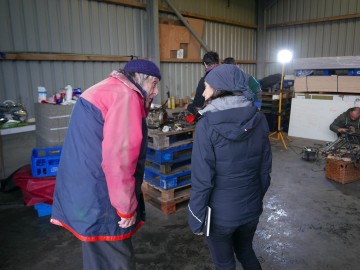
Demo day at last. Andy, as we mentioned, was a professional musician in his previous life—he had played on Top of the Pops and The Old Grey Whistle Test. So when he sat down to rehearse for the demo on Thursday morning, perched on a wooden crate in shorts and hiking boots and a down jacket, tapping at the keys of a salvaged Casio, the other islanders laughed and jibed goodnaturedly: ‘You’ve come a long way, Andy!’ The crisis at the quarry had been overcome, or rather bypassed completely, by ten o’clock: just as the insurance problem was solved, we decided it would be easier to stage the demo at the pier near the shed, so that no major moving of equipment would be involved. Now momentum was gathering towards the final event.
The demo was scheduled for after lunch. Word spread and by late morning a small crowd started to gather. We were busy with small jobs: like untangling rope for the pulley to suspend the mass, a 25-litre water container, from a long metal pole extending off the fork of a tractor Hamish had driven over from his farm. The motorcycle chassis that formed the heart of the machine was strapped to a wooden pallet. We only had to figure out how to lift the weight into the air—in Madeira we had used a solar panel, but that was not an option in Orkney. Various attempts were made, including hooking up the battery from Mike’s car, but with no success.
The school bus pulled into the parking lot in front of the pier shed and the children got out. They lined up in front of the crowd and showed drawings of the gravity batteries they had designed earlier in the week. One child broke down under the pressure and sobbed loudly, but eventually held up his drawing between shaking hands. The weather was calm and dry. We handed out Madeiran sweets to the kids, who wore reflective vests for safety. Everyone stood facing us in a semicircle and waited for the show to begin.
At the last moment a solution was found: James improvised an attachment to a rechargeable electric drill and used it to drive a super low-gear winch, slowly raising the water container. It seemed a bit of a cheat—though in fact it wasn’t, since the island’s grid is powered by renewables—but the mass was now suspended, the energy was stored until needed, and that was the main point. We called for everyone’s attention; released the mass; wires were connected and the keyboard came to life. Andy played ‘Ode to Joy’, followed by the theme tune to The Flintstones for the children. The performance lasted several minutes, then the keyboard fell silent at the instant the water container touched the ground. The crowd went wild. We did it again, and then again—the last time letting the kids take turns banging out some noise. It was a success. We cleaned up as dusk fell.
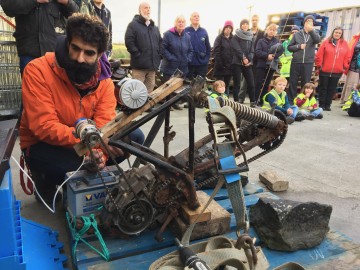
That evening there was a gathering at the community centre. Andy led a discussion with ourselves and some of the islanders, including Hamish and Mel and their children, ‘Submarine’ Mike, Ivan and his son Jordan, and many others, that felt productive. people discussed past achievements like the installation of the massive community-owned wind turbine, along with possible futures of the community and the island itself. We tried to impress the point that, given enough time and ideal conditions, their energy storage solution (or ‘Newton Machine’) would not be a gravity battery—which was something we had created out of the particular materials and terrain of Madeira—but rather a bespoke solution for Eday, built not from Madeiran sucata but from Orcadian bruck, taking advantage of local conditions, like a flow battery made with seawater. But we had three days to produce something spectacular with the community, so we decided to make an Eday version of a gravity battery—and according to those terms, we succeeded. As we sat around talking into the night, surrounded by absolute darkness except for the lights of neighbouring islands and the hostel in the distance, we also agreed that the machine we built was, in some real sense, a social machine.
We hoped that our strange event on Eday, our intervention of sorts, had made an impact on the community. We received a positive sign from Andy the day after we returned, in the form of a message that read: ‘I’m about to order my very first angle grinder, just so I can make my own sparks, just for the sheer fun of it.’ He said he’d been inspired to ‘have a go’. Between Andy’s words (and music), Clive’s stories, Mike’s submarine, Mick’s motorcycle, Ivan’s joyful exclamations of ‘happy days!’, the schoolchildren’s imaginative designs, and Hamish’s son Robbie melting aluminium in a kitchen pot with a blowtorch to cast parts for the gravity battery, we concluded that some good had come of the trip. The gravity battery itself, meanwhile, remains on the island—being too heavy to transport—and will hopefully power Andy’s reconfigured Casio keyboard through the winter months.

